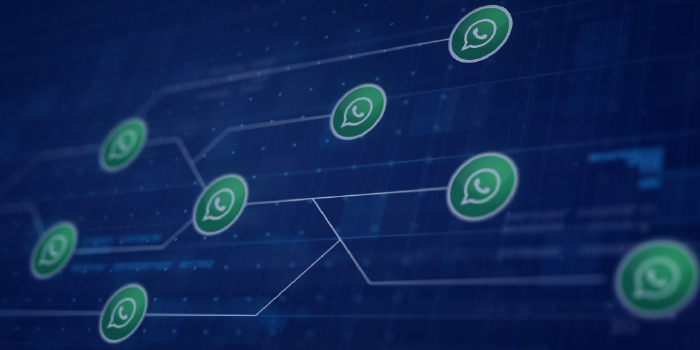Of all the ways to generate high-quality leads, nurture them, and eventually move them through the pipeline, email marketing remains the best.
Some say it’s “dead,” but the numbers tell us every $1 you spend on email returns $36 on average. That’s greater than any other marketing channel.
Anyone who tells you email doesn’t work anymore is simply doing it wrong.
To keep you from being one of them, I’ll walk through the fundamentals of email lead generation. And I’ll share my best practices for building a strong email marketing strategy.
What is Email Lead Generation?
Email lead generation is the process of acquiring new leads for your business through email opt-in forms. When your target audience subscribes to your email list, they become potential leads you can nurture through targeted and personalized email campaigns.
An opt-in form could be…
- a pop-up on your website
- a checkbox during the checkout process
- a form on a landing page
- a gated info product (e.g., an eBook or whitepaper)
- early access to a product or service
- exclusive sales discounts
- an opt-in through social media or paid ads
Essentially, it’s any way you can get someone to give their email address in exchange for something of value.The goal of lead generation is to capture the interest of potential customers and eventually convert them into paying customers. Whether you’re starting an AI automation, a service-based business, or a copywriting business, email lead generation can help you turn strangers into paying customers affordably and effectively.
What Makes Email Lead Generation so Valuable?
Capturing potential customers’ email addresses is an important step in the lead generation process because it allows you to reach them directly and personally. With email, you have control over the message, timing, and frequency of your communication.
99% of people check their inbox at least once every day, which explains why 77% of marketers say they’ve seen an uptick in email engagement in the last year.
Email also has an ROI of ~36x thanks to its relatively low cost and ability to reach a large audience quickly.
Besides high ROI and maximum reach, several things make email marketing lead generation great:
- Effortless personalization: With email automation tools, setting up trigger-based marketing emails makes it really easy to personalize content for your audience.
- In-depth analytics: You can monitor open rates, click-through rates, and conversions for each campaign and customer segment. And you can use that data to refine your targeting.
- Educate your audience: Subscribers who already use your product will get more value out of it. The ones who don’t are much likelier to once you earn their trust through useful content.
It’s also worth mentioning email is the path of least resistance.
They choose to give you their information. And you’re giving them something of value in return.
Compared to cold calling, it isn’t just non-intrusive. It’s welcome and expected.
What about Buying a List of Email Leads?
Don’t do it.
You’re shooting yourself in the foot if you do.
- Laws like CAN-SPAM and GDPR (plus advancements in email filtering) mean you’ll almost definitely get your ISP blocked.
- The people on your list don’t know you. And they probably don’t know your business.
- They didn’t opt into your emails, either. There’s a higher chance of them marking your messages as spam.
- Getting marked as spam gives you a low sender score, and you’ll have low deliverability rates.
I’m not saying you won’t close any deals with cold emails. You definitely can.
However, excessively emailing unqualified prospects is a much less efficient approach than email lead generation.
When you follow email lead generation best practices, you’ll be able to achieve better results.
10 Best Practices for Email Lead Generation
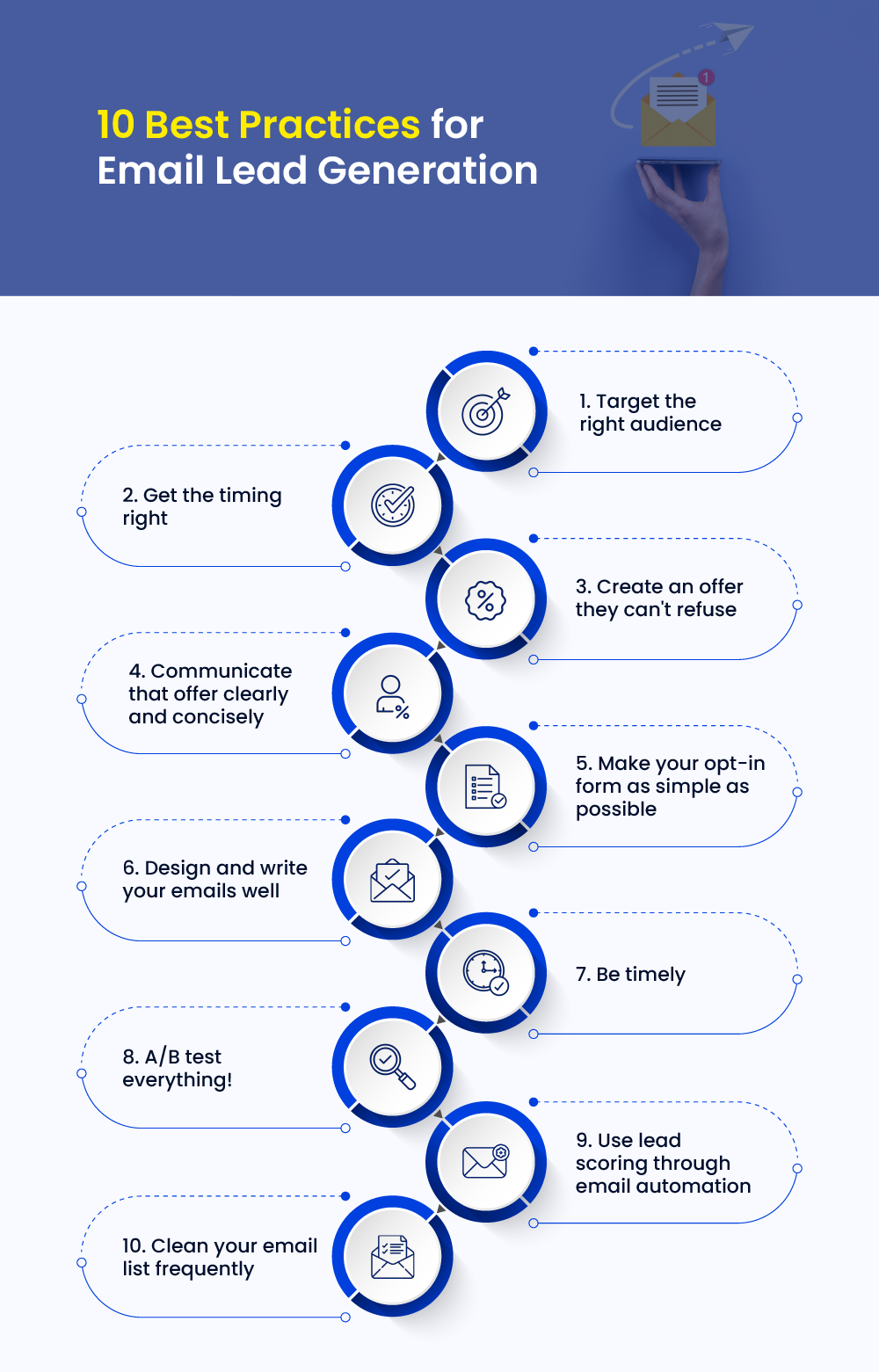
1. Target the right audience
If you don’t know who you’re speaking to, you won’t be able to create valuable content they’ll actually want to trade their email address for.
You’ll have to create a buyer persona. To start, consider demographic/firmographic and psychographic data.
- Demographics include gender, age, education level, income/financial status, job titles and industries.
- Firmographics are like demographics, but for businesses. They include company size, revenue, industry, and vertical.
- Psychographics are your customers’ interests and lifestyle choices.
This information weeds out the leads who would never buy your product.
To really understand where your audience is coming from, though, you’ll have to dive deeper.
- What are their pain points?
- Why do they want to buy your product/service?
- How do they communicate over various channels?
- Which decision-maker will you target?
These four questions are the most important considerations.
Nobody’s going to download your eBook because they’re a 40-year-old VP at a company doing $10 million+ MRR.
They’re going to because they need something. And it’s your job to communicate that something to them.
2. Get the timing right
The average sales cycle can take 102 days to close.
At each stage of the sales funnel, different types of content will hold more weight. And customers resonate with different members of the buying process.
To map out your customer journey, consider the following:
- How will your prospects find your business?
- What are their typical touchpoints, and how can you make sure you’re present at each stage?
- What content is most valuable to them at each stage of the funnel?
For example, to draw in buyers lower in the funnel, you’d host a webinar. But, to grab emails from potential buyers in the awareness stage, you might offer a whitepaper or guide.
3. Create an offer they can’t refuse
Once you know who you’re targeting and how far down the funnel they are, you can start thinking about your offer.
This sounds simple enough. Really, it’s anything but.
There are three things that go into a fantastic offer:
- Need — Is your audience asking for this information or service?
- Value — Can you actually deliver what they need in a high-quality way?
- Urgency — Will buyers take action now or later?
Without any one of these three components, your offer will flop.
In general, it’s best to offer one of the following:
- Simple, free services like a website audit or a tool
- Calculations or free estimates
- Industry-specific pieces of content, such as eBooks, whitepapers, or guides
- Courses
- Webinar registrations
- Newsletters
- A 10-20% discount for your product
Pro tip: A/B test multiple lead magnets to see which offers bring in the most qualified leads.
4. Communicate that offer clearly and concisely.
No matter how great your offer is, your lead magnet won’t get much engagement if your lead has no idea what you’re offering and why.
To make sure you’re communicating effectively, consider these questions:
- Is each sentence in my copy necessary? If not, get rid of it.
- Does this present an obvious call to action?
- Would I give up my email for this?
HubSpot’s website grader is an excellent example of a well-done lead magnet.
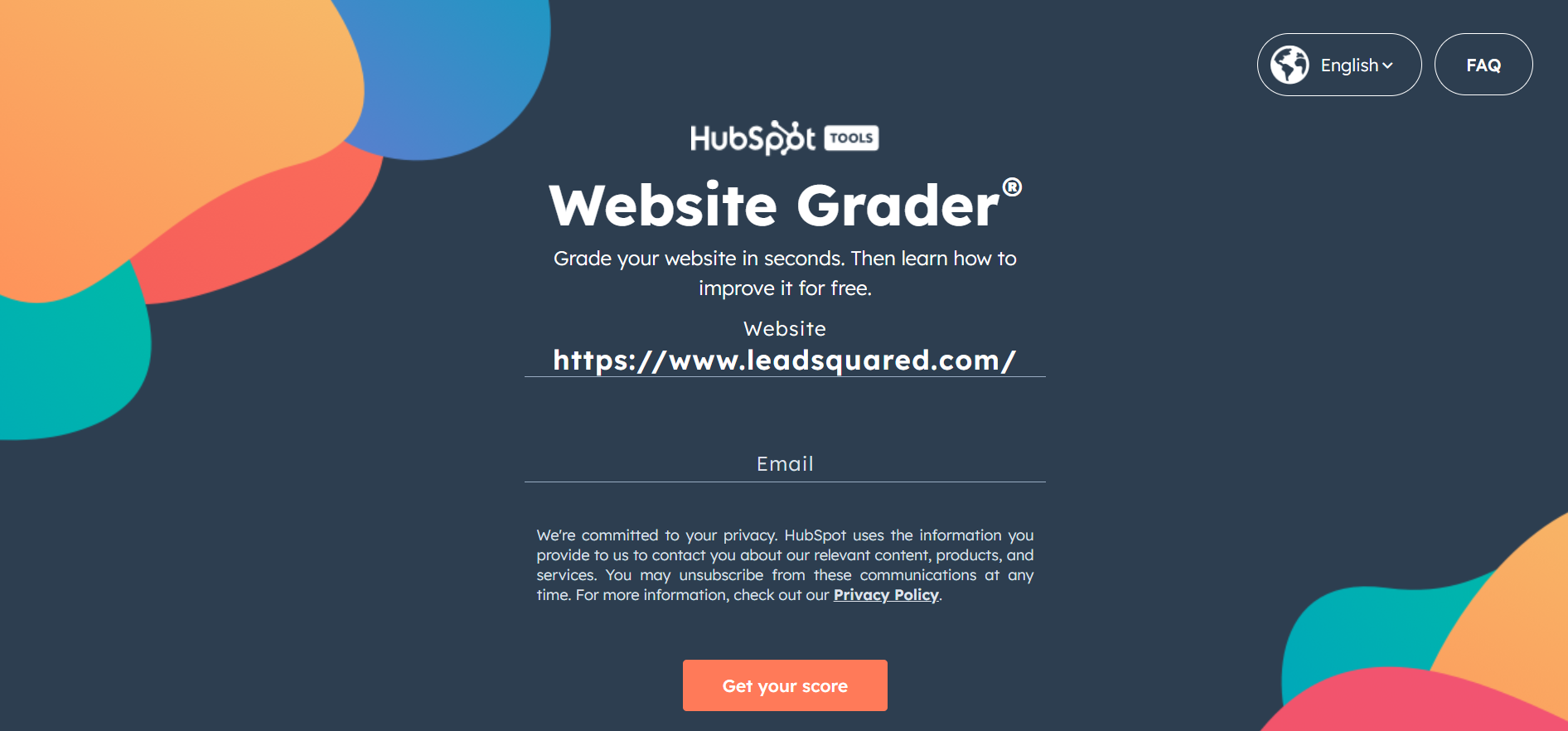
As soon as you arrive on the landing page, you’ll see the simple form above.
The message is clear:
- Enter the site you want to grade.
- Enter your email address.
- Click the orange button.
- Receive your score.
This lead magnet is fantastic because it actually gives the company more than just a customer’s email address.
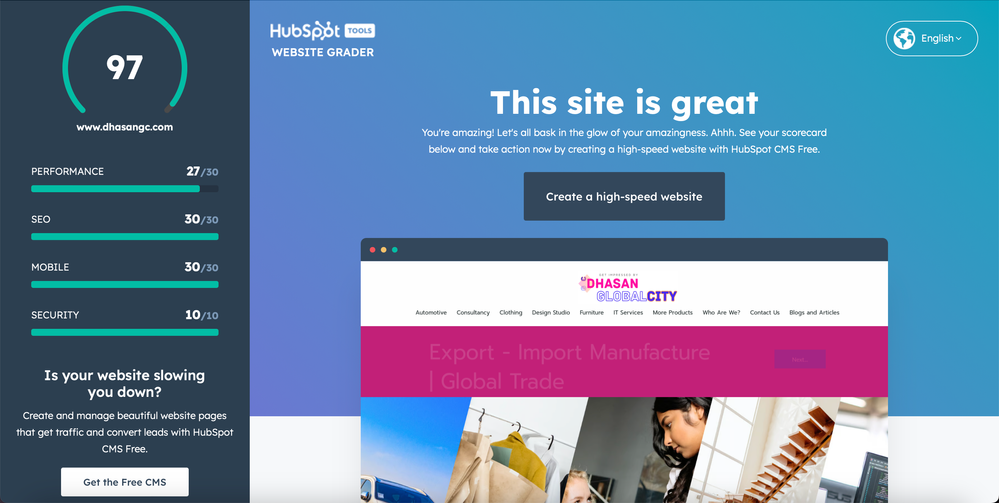
When HubSpot gives you your score, it will know:
- The type of website you have
- What its current problems are
- How to potentially sell HubSpot CMS
Genius, really.
5. Make your opt-in form as simple as possible
Remember: You only need their email address.
Avoid unnecessary fields on your opt-in forms. The more you ask for, the less likely prospects are to give up their information.
Plus, complicated forms make it look like you’re going to spam them.
We really like this opt-in form from Productboard.
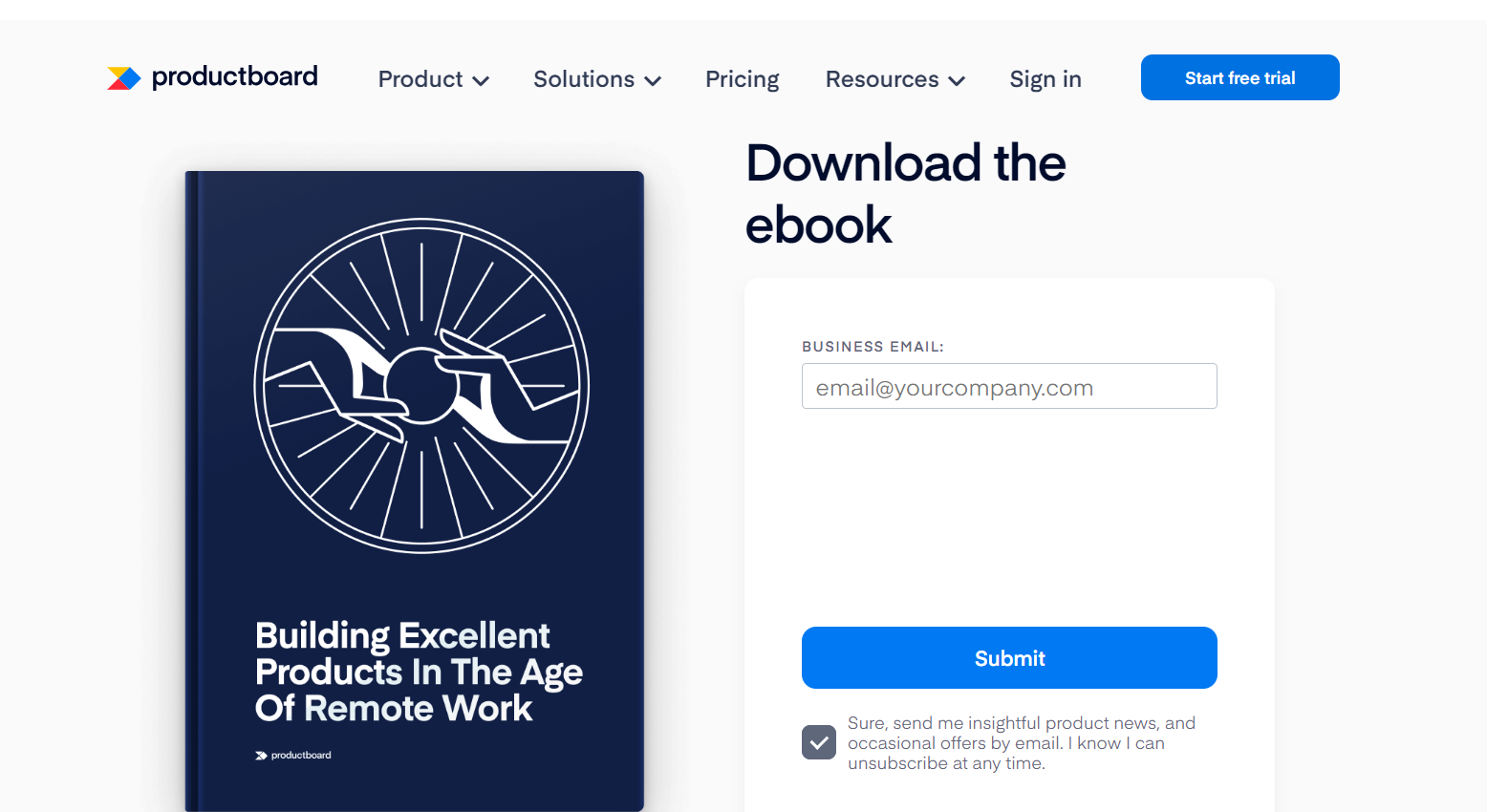
It’s front-and-center, above the fold, and has no distracting links or buttons.
It only has an email field and a checkmark for a subscription option. Perfect.
If you’re going to include multiple fields, consider why each is necessary and if there’s a way to collect that information later.
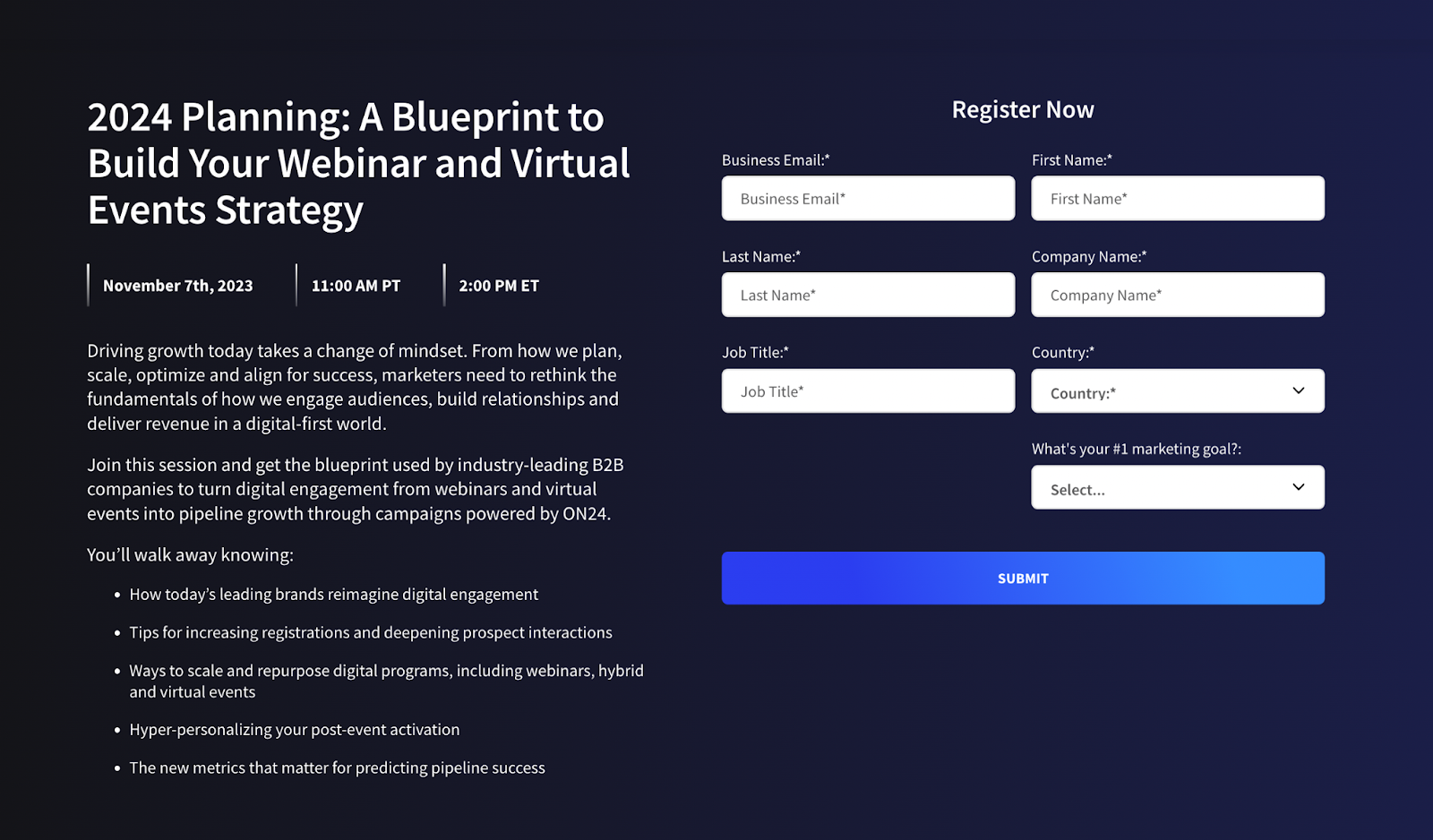
In the example above, it would be appropriate to ask more probing questions because it’s a B2B webinar registration.
Since webinar registrants are generally further along in the purchase funnel, they’re more willing to give up this information. Plus, the host might use some of the info to create a more targeted experience.
6. Design and write your emails well
First impressions are lasting ones, and you want to hit the ground running with every lead you bring in. You might want to hire a designer and copywriting business or train your team to improve the emails.
Here’s a breakdown of a solid newsletter intro email from MailerLite.
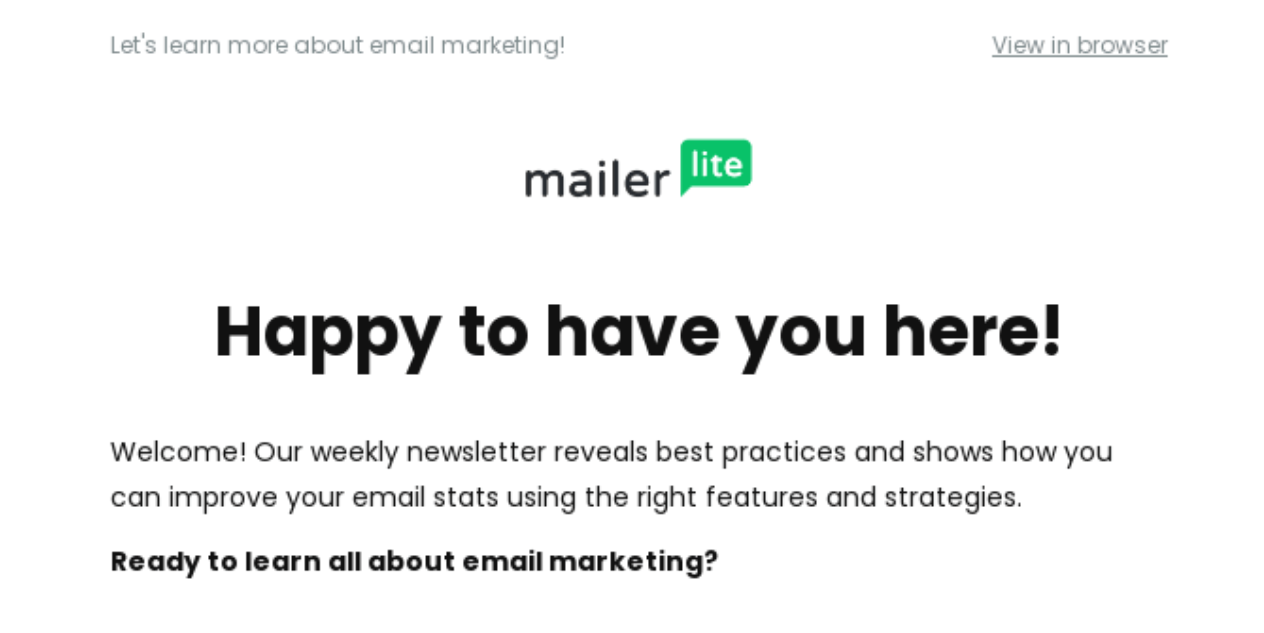
First and foremost, it adopts a warm and friendly tone without being over the top. This is on-brand for the company, and consistent with its website copy.
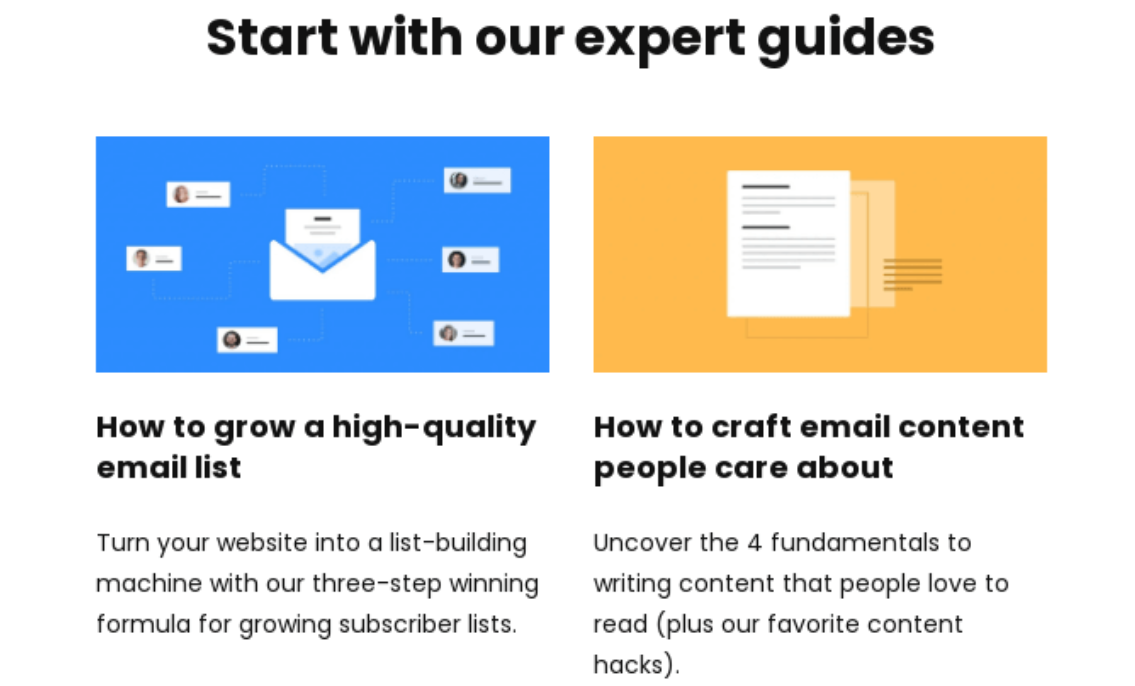
On the first scroll, the recipient immediately sees what to do next. They can browse through more content they might find interesting.
This keeps them engaged.
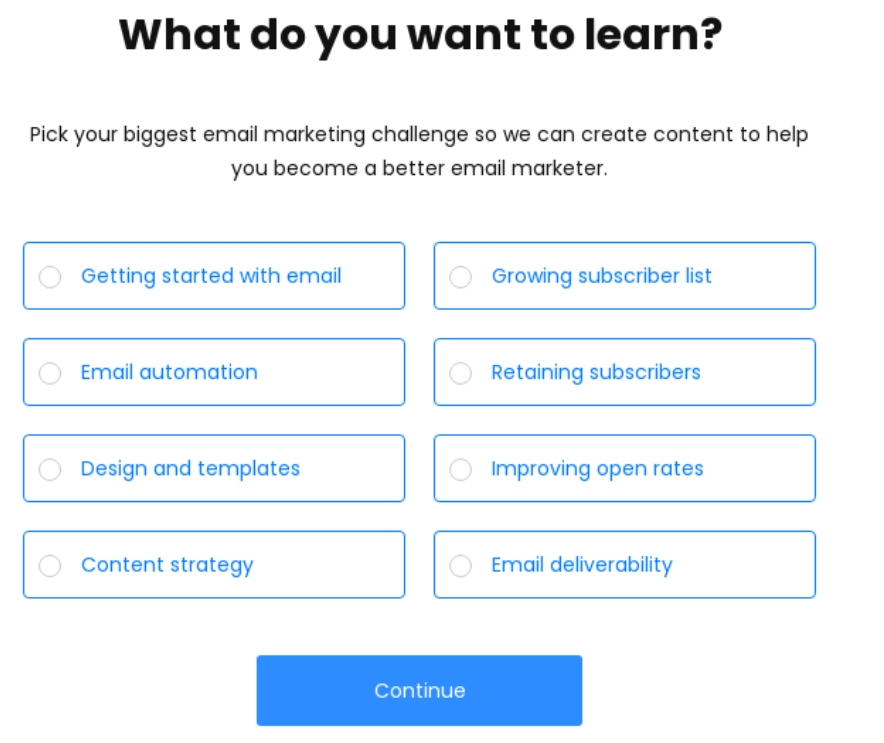
Asking about each reader’s preferences helps them personalize the newsletter experience (and other promotions) on an individual level.
Of course, the contents of your email will depend on…
- your brand voice
- the offer you’re promoting
- the lead magnet type
…but the point remains the same. Focus on engaging your new readers, suggesting a few things they might like, and finding ways to play to their interests.
7. Be timely
Timeliness is life or death when it comes to email marketing. It’s best to send your first email within two minutes of someone opting into your content.
Here’s how you can keep it speedy:
- Automate lead capture with CRM and marketing automation.
- Create a welcome and nurture series to automatically send emails based on a timing schedule.
- Build personalized email marketing workflows that will trigger the right messages when they meet certain criteria (e.g., registering for a webinar vs. downloading an eBook).
You’ll also want to consider when you’ll send each email.
Remember how we said, “Timing is everything”? Well, sending too much or too little will turn your fresh leads away.
Unfortunately, there’s no optimal send frequency. The best way to estimate it in the beginning is to give your subscribers autonomy. When they can control their email frequency, they’re much less likely to cut you off entirely.
8. A/B test everything!
A/B testing lets you create a controlled environment and compare different versions of the same thing. For example, maybe one “Sign Up” CTA gets more clicks than another because of its color.
The most important elements to test are:
- CTA buttons
- Design elements
- Images
- Email subject lines
- Preview text
By comparing the results from each version, you can better understand what motivates your audience.
9. Use lead scoring through email automation
Even if you get tons of traffic to your opt-in landing page and it gets tons of clicks, there’s no guarantee those leads are qualified.
If your email lead generation strategy isn’t bringing in the right leads, your sales team will spend way too much time chasing people who will never convert.
Some email marketing software lets you score and tag each new lead based on page views, email clicks, etc., so you can build a big-picture view of each contact.
Let’s say you’re a marketing manager at a B2B SaaS company. You might build out separate tracks for new subscribers based on their role — e.g., the technical buyer or an end-user.
Once you’ve created these marketing tracks, you can easily place new subscribers into certain nurture streams based on these qualifications.
10. Clean your email list frequently
There’s nothing worse than finding out you have a ton of inactive subscribers on your email list. It lowers engagement rates and deliverability rates. And it wastes all the time you put into generating those leads in the first place.
To avoid this issue, create a process to scrub your email list regularly. For inactive subscribers, it’s as simple as setting up an “Are you still interested?” sequence and removing those who don’t respond.
For invalid email addresses, you can remove them manually or use an email list cleaner.
Final Thoughts
The framework for email lead generation is simple: attract, convert, and retain. But executing it requires understanding your audience, creating valuable content, and constantly testing and optimizing your strategies.
To efficiently handle a large lead database across different buying stages, use marketing automation software. Then, build out sequences that help you communicate and personalize at scale.
If you’re looking for a tool that streamlines email marketing workflows, allows you to create no-code email templates, and monitors your email campaigns, LeadSquared is your best bet! Get in touch with the team to start generating high quality leads using email marketing.
FAQs
To drive traffic to your lead magnet, consider using social media, paid advertising (PPC), content marketing, and business partnerships. You can also use SEO tactics like link building to improve organic search rankings, but this will take considerably longer.
Referrals are far and away the best leads out there. But it’s unlikely your referral program brings you a consistent stream of high-quality leads. The most reliable way to generate leads is through email marketing. By building out targeted lead magnets, opt-in forms, and email sequences, you can attract and convert new leads on a consistent basis.









